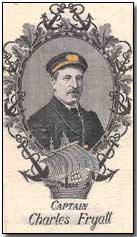Primary Documents - German Government Statement on the Execution of Captain Fryatt, 10 August 1916
 On 28 March 1915 Captain
Charles Fryatt, a British merchant captain, attempted - but failed - to ram
and sink a German submarine, U-33. This came in the wake of
repeated attempts by the German navy to sink his vessel - the Great Eastern
Railway Steamer Brussels sailing the Rotterdam/British east coast
route.
On 28 March 1915 Captain
Charles Fryatt, a British merchant captain, attempted - but failed - to ram
and sink a German submarine, U-33. This came in the wake of
repeated attempts by the German navy to sink his vessel - the Great Eastern
Railway Steamer Brussels sailing the Rotterdam/British east coast
route.
Hailed by the Allied nations as a hero - it was variously believed that he had succeeded in his patriotic act, Fryatt was officially rewarded by the British government for his actions.
Fryatt was however taken prisoner by the Germans on a subsequent voyage and charged with being a franc-tireur - a most serious charge and one that carried the death sentence. So began a war of words between the German and British governments over his case. Britain argued that Fryatt had been acting in self-defence, while Germany maintained that Fryatt's action in attempting to ram U-33 was undertaken without provocation.
In the event Fryatt was tried and convicted by a German court and executed on 27 July 1916. The case achieved widespread notoriety in Britain and Captain Fryatt's name - and face, in newspapers, magazines and even bookmarks - was celebrated throughout Britain.
Click here to read the German government's official statement following Fryatt's execution. Click here to read the response written by former British Prime Minister Arthur Balfour. Click here to read the official British government statement on the matter.
Reproduced below is Germany's reply to the British statement.
Official German Government Statement, 10 August 1916
It is only too intelligible that the English Government attempts to justify Captain Fryatt's action, for it is itself in a high degree a fellow-culprit. Captain Fryatt, acting as he did, acted only on the advice of his Government.
The British Government's statement intentionally misleads the public. Captain Fryatt did not attempt to forestall an under-water attack, without warning, by the submarine. The U-boat was above water, and signalled to him when above water to stop, according to the international code of naval warfare.
Therefore, he did not merely attempt to save the lives of his crew, because they were not endangered. Moreover, on March 28, 1915, Captain Fryatt allowed the submarine, which was approaching his ship for the purposes of examination, to draw up close, so as to ram her suddenly and unexpectedly, his object being to destroy her, and so gain the reward offered by the British Government.
This act was not an act of self-defence, but a cunning attack by hired assassins. Captain Fryatt boasted of his action, though happily he failed to attain his object. This was brought home to him during the trial by witnesses from the crew of the submarine in question, whose evidence was against him. The British Parliament believed he had succeeded and praised his conduct, and the British Government rewarded him.
The German War Tribunal sentenced him to death because he had performed an act of war against the German sea forces, although he did not belong to the armed forces of his country. He was not deliberately shot in cold blood without due consideration, as the British Government asserts, but he was shot as a franc-tireur, after calm consideration and thorough investigation.
As martial law on land protects the soldiery against assassination, by threatening the offender with the penalty of death, so it protects the members of the sea forces against assassination at sea.
Germany will continue to use this law of warfare in order to save her submarine crews from becoming the victims of francs-tireurs at sea.
Source: Source Records of the Great War, Vol. IV, ed. Charles F. Horne, National Alumni 1923
A "lazy liz" was a heavy artillery shell fired by the Allied battleship Queen Elizabeth.
- Did you know?
